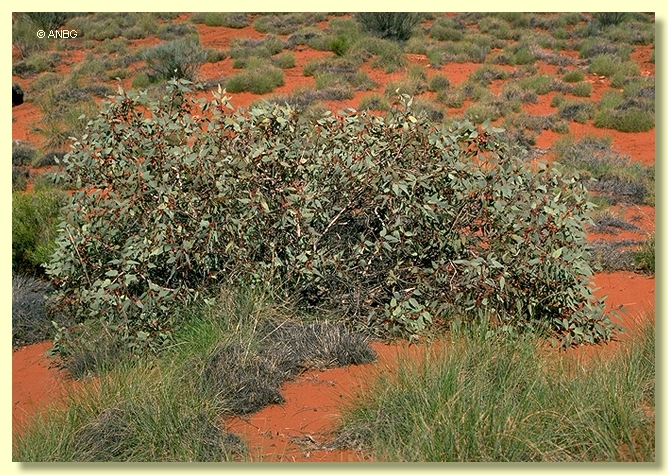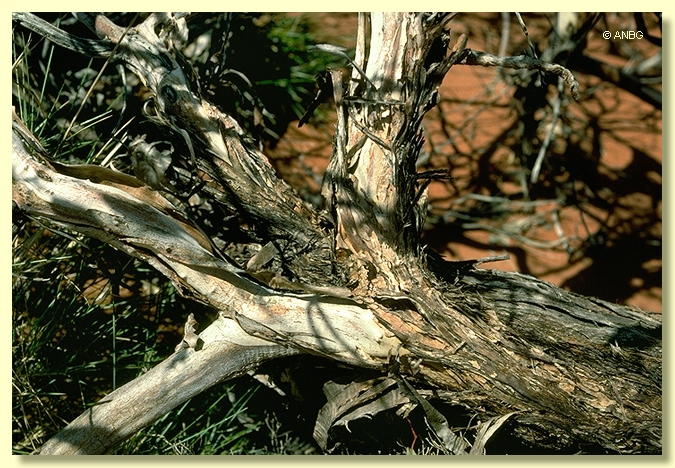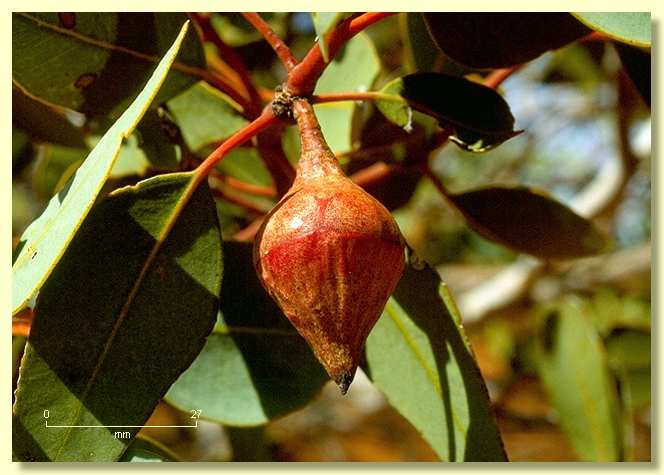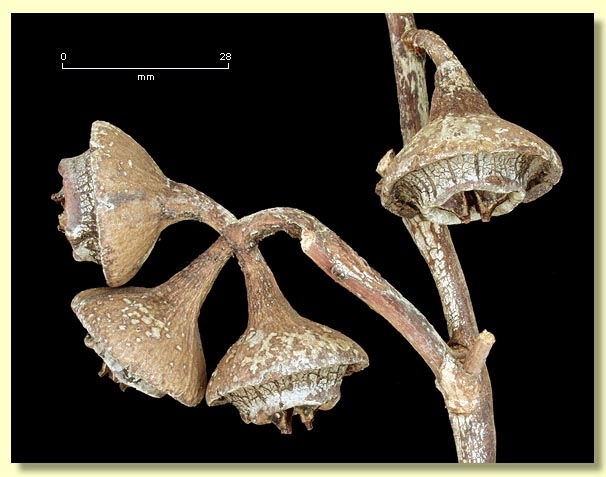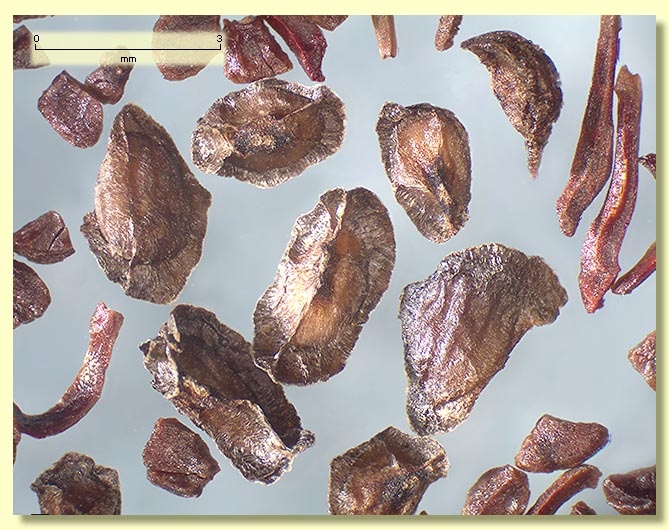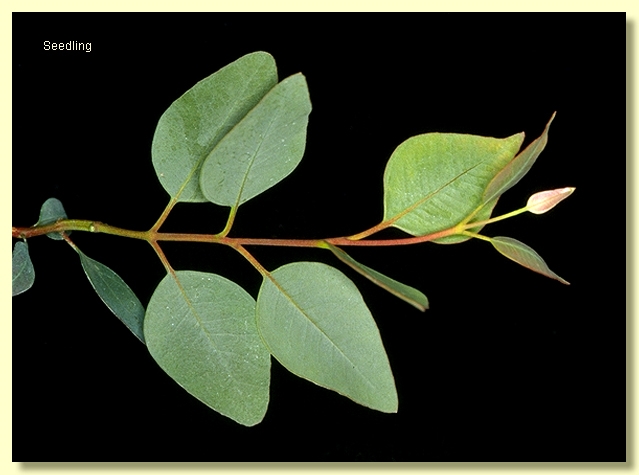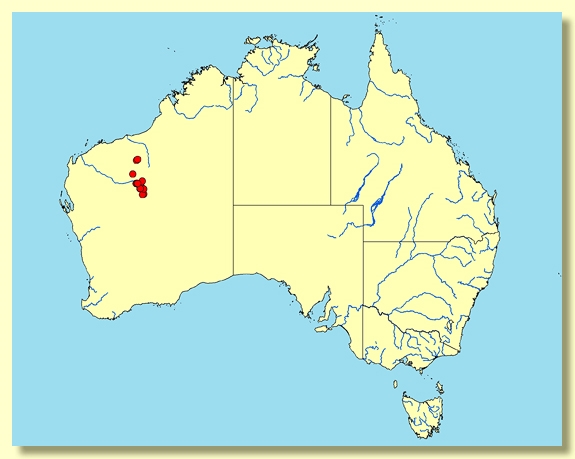Eucalyptus | Symphyomyrtus | Bisectae | Destitutae | Curviptera | Xylocarpae
Euclid - Online edition
Eucalyptus rameliana
Eucalyptus rameliana F.Muell., Fragm. 10: 84 (1876).
Eucalyptus pyriformis var. rameliana (F.Muell.) Maiden, Crit. Revis. Eucalyptus 2(17): 232, 235, Pl. 76 (5).
T: beyond Alfred and Marie Range, Western Australia, June 1876, E.Giles; holo: MEL.
Mallee to 3 m tall. Forming a lignotuber.
Bark smooth throughout, grey and pinkish grey to brown.
Branchlets oil glands absent from the pith; not glaucous.
Juvenile growth (coppice or field seedlings to 50 cm): not seen.
Adult leaves alternate, thickish, petioles 1–2.5(3) cm long; blade ovate to broadly lanceolate, 5–11 cm long, 2.3–5 cm wide, base rounded to tapering, apex pointed, concolorous, dull, grey-green to blue-green or pale green, side-veins at a wide angle to the midrib, reticulation dense or obscure, intramarginal vein present, oil glands intersectional or few.
Inflorescence axillary, peduncles terete, down-turned, 0.7–1.7 cm long, buds solitary or less commonly in 3s, pedicellate, pedicels 0.5–1.2 cm long. Mature buds ovoid to globular (2.5–3.7 cm long, 1.5–2.7 cm wide), scar present, operculum conical or rounded and beaked (1.5–2.7 cm long), stamens more or less oblique with some of the inner stamens partly inflexed, anthers cuboid, versatile, dehiscing by longitudinal slits, style long and straight, stigma tapering, locules 4(5), the placentae each with 8 vertical ovule rows. Flowers pale yellow, rarely red.
Fruit on down-turned peduncles, stoutly pedicellate, pedicels 0.3–1.2 cm long, hemispherical to shallowly and broadly obconical, 1.2–1.7 cm long, 2.3–3.5 cm wide, disc raised, valves 4(5), slightly exserted.
Seeds greyish brown, 2.5–4.5 mm long, flattened-pyramidal, dorsal surface ± smooth, sides ridged, with a ± encircling marginal, hilum ventral to terminal.
Cultivated seedlings (measured at ca node 10): cotyledons bisected; stems rounded in cross-section; leaves always petiolate, opposite for 6–10 nodes then becoming alternate, ovate, 4–7 cm long, 2.3–3.7 cm long, base rounded to tapering, dull or slightly glossy, green to grey-green. New growing tips may be faintly glaucous but wax not persisting as leaves expand.
Flowering has been recorded in May and October.
May be suitable as an ornamental species in arid areas.
A low growing desert mallee endemic to Western Australia, found only in the Little Sandy Desert south-east of Newman. It occurs on red sand dunes.
Eucalyptus rameliana belongs in Eucalyptus subgenus Symphyomyrtus section Bisectae subsection Destitutae because the buds have two opercula, cotyledons are Y-shaped and branchlets lack oil glands in the pith. Within this subsection E. rameliana is one of about 30 closely related species and subspecies forming series Curviptera which is characterised by having large buds in umbels of one, three or seven, stamens erect to oblique in bud and fruit that are large and have an ascending disc and prominent valves.
Eucalyptus rameliana is easily distinguished from other species in its area of occurrence by its low stature, dull crown, usually solitary large red buds that are pendulous, smooth (not ribbed), ovoid to rounded and produce pale yellow, or rarely, red showy flowers. Its fruit are also pendulous and smooth, to 3.5 cm wide with a prominently raised disc.
Eucalyptus rameliana: after Prospero Ramel (flor. 1877). Prospero Ramel was responsible for introducing eucalypts into Algeria and southern France.

